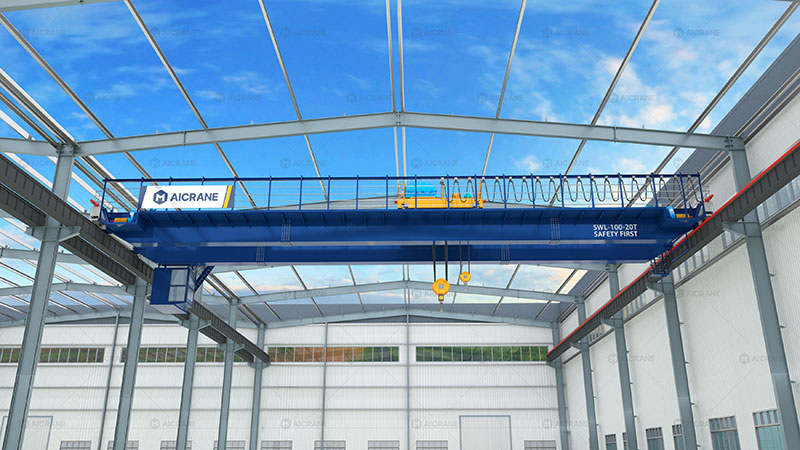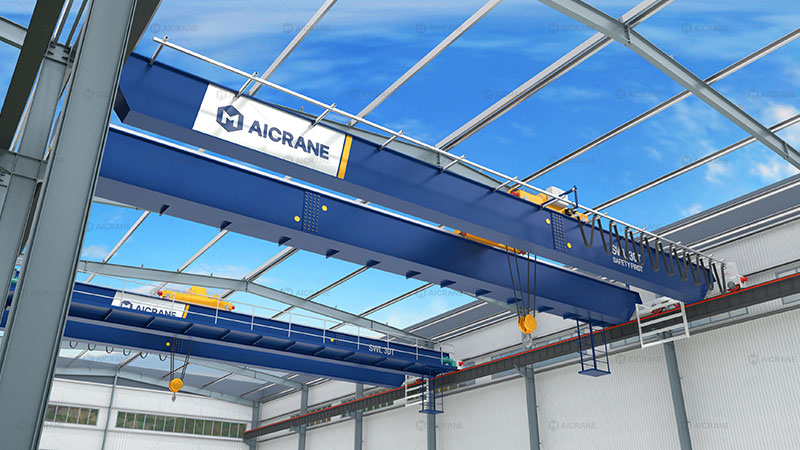In today’s dynamic industrial environment, double girder overhead cranes are essential tools for efficient material handling. As businesses aim for higher productivity, safety, and consistency, automation has become a key differentiator. Double girder cranes are now available with varying levels of automation – manual, semi-automatic, and fully automatic – each offering unique benefits and suited for different operational needs.
This article explores these automation levels in depth, examining their features, advantages, limitations, and best-use scenarios to help businesses make informed decisions.

Manual Operation: Traditional but Reliable
What Is Manual Operation?
Manual operation involves direct control by a double girder overhead crane operator using a pendant control, operator cabin, or wireless remote. Every movement – lifting, lowering, trolley travel, and bridge travel – is performed in real time by the operator without automation support.
Key Features
-
Complete reliance on operator for all movements
-
Operated via remote, pendant, or cabin
-
Minimal or no automation components
-
Basic safety features like mechanical limit switches
Advantages
-
Cost-Effective: Lower purchase and installation costs
-
Simple Maintenance: Fewer electronics mean easier servicing
-
Operational Flexibility: Skilled operators can adapt quickly to changing situations
Limitations
-
Labor-Intensive: Requires continuous manual intervention
-
Operator Fatigue: Human error and fatigue may affect safety and productivity
-
Lower Precision: Performance depends on the skill level of the operator
Suitable Applications
Manual cranes are best used in:
-
Workshops with infrequent or non-repetitive lifting tasks
-
Maintenance operations or repair shops
-
Facilities where budget is a major constraint

Semi-Automatic Operation: The Bridge Between Manual and Full Automation
What Is Semi-Automatic Operation?
A semi-automatic crane combines manual commands with programmed responses. The operator initiates a task, and the overhead crane completes specific functions automatically. This setup uses PLCs (Programmable Logic Controllers), sensors, and limited software logic.
Key Features
-
Hybrid control: manual input triggers automated movement
-
Integrated sensors and positioning systems
-
Routine tasks like preset lifting and travel cycles are automated
-
Enhanced safety systems such as soft start/stop and overload detection
Advantages
-
Improved Efficiency: Reduces time spent on repetitive operations
-
Repeatable Performance: Ideal for environments with consistent workflows
-
Higher Safety: Embedded logic systems help prevent operator error
-
Upgradeable: Often designed to scale toward full automation
Limitations
-
Moderate Investment: More expensive than manual systems
-
Training Requirement: Operators must understand system logic and sensors
-
Limited Autonomy: Complex or non-standard tasks still require manual intervention
Suitable Applications
Semi-automatic cranes are commonly used in:
-
Steel fabrication plants
-
Precast concrete manufacturing
-
Warehousing and logistics
-
Any facility with moderate automation goals
Full-Automatic Operation: Intelligent Material Handling
What Is Full-Automatic Operation?
In a fully automated system, the crane operates without manual input. All motions are controlled through an integrated system based on pre-programmed logic, real-time sensor data, and sometimes AI or machine learning algorithms.
Key Features
-
Fully autonomous lifting, traveling, and positioning
-
Real-time data from sensors, radar, and cameras
-
Integration with MES (Manufacturing Execution Systems) or ERP
-
Predictive maintenance, anti-collision, and smart diagnostics
Advantages
-
Maximum Productivity: Fast, precise, and repeatable operations
-
Labor Cost Savings: Minimal need for on-site operators
-
24/7 Operations: Ideal for continuous production environments
-
Data Collection and Optimization: Enables real-time analytics and performance tuning
Limitations
-
High Upfront Cost: Requires investment in advanced technology
-
Complex Integration: Involves collaboration with IT and automation experts
-
Specialized Maintenance: Requires skilled personnel for system upkeep
Suitable Applications
Fully automatic industrial overhead cranes are ideal for:
-
Automated warehouses and logistics hubs
-
Steel coil storage and handling
-
Ports and shipyards
-
Smart factories under Industry 4.0 initiatives
Comparison Table: Manual vs. Semi-Automatic vs. Fully Automatic
| Feature | Manual Operation | Semi-Automatic Operation | Fully Automatic Operation |
|---|---|---|---|
| Operator Involvement | Full | Partial | None |
| Cost | Low | Medium | High |
| Efficiency | Basic | Improved | Maximum |
| Safety Level | Basic (Limit Switches) | Enhanced (Sensors, Logic) | Advanced (AI, Anti-Collision) |
| Suitability for Repetitive Tasks | Poor | Good | Excellent |
| Integration with Smart Systems | No | Limited | Full Integration |
| Maintenance Complexity | Low | Medium | High |
| Scalability | Low | Medium | High |
Choosing the Right Automation Level
Key Considerations
When selecting the appropriate automation level for your crane operations, consider the following:
-
Budget: Manual systems are cheaper, but automation may yield long-term ROI
-
Operational Requirements: High-volume or repetitive tasks benefit from automation
-
Labor Resources: Automated cranes reduce reliance on skilled manual operators
-
Space and Safety Constraints: Automation improves safety in tight or hazardous environments
-
Production Goals: Full automation ensures optimal speed and consistency
Partnering with the Right Crane Supplier
Implementing automation successfully depends heavily on working with a capable crane provider. Look for eot crane suppliers who offer:
-
Customized system designs
-
Installation, commissioning, and training
-
Remote diagnostics and technical support
-
Future upgrade paths from manual to semi or full automation
A trustworthy supplier ensures smooth integration, long-term service, and optimal system performance.
Future Trends in Crane Automation
The future of double girder overhead crane automation lies in:
-
AI-powered decision-making
-
Remote operation using digital twins and simulation
-
Self-diagnosing cranes with predictive maintenance
-
Full integration into smart production ecosystems
As Industry 4.0 and digital transformation accelerate, fully automated crane systems will become the norm, not the exception.
Conclusion
Choosing between manual, semi-automatic, and fully automatic double girder overhead cranes depends on your facility’s operational needs, budget, and vision for the future. Each automation level brings its own benefits and trade-offs.
Manual operation provides cost savings and simplicity. Semi-automatic cranes offer a balanced approach for facilities seeking efficiency with some flexibility. Fully automatic cranes are the future of high-throughput, intelligent material handling.
With thoughtful planning and the right technical partner, companies can transform their overhead crane systems into a strategic asset that drives safety, performance, and long-term success.
